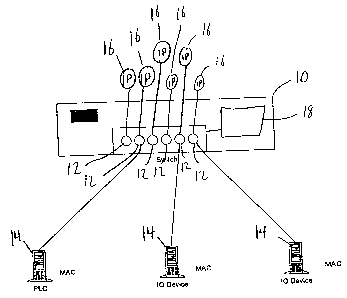Some of the information on this Web page has been provided by external sources. The Government of Canada is not responsible for the accuracy, reliability or currency of the information supplied by external sources. Users wishing to rely upon this information should consult directly with the source of the information. Content provided by external sources is not subject to official languages, privacy and accessibility requirements.
Any discrepancies in the text and image of the Claims and Abstract are due to differing posting times. Text of the Claims and Abstract are posted:
| (12) Patent Application: | (11) CA 2362433 |
|---|---|
| (54) English Title: | NETWORK ADDRESSING BASED ON THE PORT OF A NETWORK SWITCH |
| (54) French Title: | ADRESSAGE DE RESEAU EN FONCTION DU PORT D'UN COMMUTATEUR DE RESEAU |
| Status: | Deemed Abandoned and Beyond the Period of Reinstatement - Pending Response to Notice of Disregarded Communication |
| (51) International Patent Classification (IPC): |
|
|---|---|
| (72) Inventors : |
|
| (73) Owners : |
|
| (71) Applicants : |
|
| (74) Agent: | SMART & BIGGAR LP |
| (74) Associate agent: | |
| (45) Issued: | |
| (86) PCT Filing Date: | 2000-12-07 |
| (87) Open to Public Inspection: | 2001-07-12 |
| Availability of licence: | N/A |
| Dedicated to the Public: | N/A |
| (25) Language of filing: | English |
| Patent Cooperation Treaty (PCT): | Yes |
|---|---|
| (86) PCT Filing Number: | PCT/US2000/033188 |
| (87) International Publication Number: | WO 2001050711 |
| (85) National Entry: | 2001-08-30 |
| (30) Application Priority Data: | ||||||
|---|---|---|---|---|---|---|
|
The present invention discloses a network switch for a computer network which
receives a network message from a network device and forwards the network
message to an appropriate destination. The network switch has a plurality of
ports for receiving and forwarding the network message. The network switch has
a logical address server which assigns a logical address to a network device
based upon the port of the network switch to which the network device is
connected.
La présente invention porte sur un système d'adressage d'un réseau informatique qui reçoit un message d'un dispositif de réseau et envoie le message réseau vers une destination appropriée. Le commutateur de réseau possède une pluralité de ports de réception et d'envoi de message, ainsi qu'un serveur d'adresse logique qui attribue une adresse logique à un dispositif de réseau en fonction du port du commutateur de réseau auquel est raccordé le dispositif de réseau.
Note: Claims are shown in the official language in which they were submitted.
Note: Descriptions are shown in the official language in which they were submitted.

2024-08-01:As part of the Next Generation Patents (NGP) transition, the Canadian Patents Database (CPD) now contains a more detailed Event History, which replicates the Event Log of our new back-office solution.
Please note that "Inactive:" events refers to events no longer in use in our new back-office solution.
For a clearer understanding of the status of the application/patent presented on this page, the site Disclaimer , as well as the definitions for Patent , Event History , Maintenance Fee and Payment History should be consulted.
| Description | Date |
|---|---|
| Inactive: IPC expired | 2022-01-01 |
| Inactive: IPC from PCS | 2022-01-01 |
| Application Not Reinstated by Deadline | 2004-12-07 |
| Time Limit for Reversal Expired | 2004-12-07 |
| Deemed Abandoned - Failure to Respond to Maintenance Fee Notice | 2003-12-08 |
| Letter Sent | 2002-01-14 |
| Inactive: Cover page published | 2001-12-18 |
| Inactive: Courtesy letter - Evidence | 2001-12-18 |
| Inactive: Notice - National entry - No RFE | 2001-12-13 |
| Inactive: First IPC assigned | 2001-12-13 |
| Application Received - PCT | 2001-12-04 |
| Inactive: Single transfer | 2001-11-23 |
| Application Published (Open to Public Inspection) | 2001-07-12 |
| Abandonment Date | Reason | Reinstatement Date |
|---|---|---|
| 2003-12-08 |
The last payment was received on 2002-09-23
Note : If the full payment has not been received on or before the date indicated, a further fee may be required which may be one of the following
Please refer to the CIPO Patent Fees web page to see all current fee amounts.
| Fee Type | Anniversary Year | Due Date | Paid Date |
|---|---|---|---|
| Basic national fee - standard | 2001-08-30 | ||
| Registration of a document | 2001-11-23 | ||
| MF (application, 2nd anniv.) - standard | 02 | 2002-12-09 | 2002-09-23 |
Note: Records showing the ownership history in alphabetical order.
| Current Owners on Record |
|---|
| SCHNEIDER AUTOMATION INC. |
| Past Owners on Record |
|---|
| DENNIS J. W. DUBE |
| RICHARD A. BAKER |